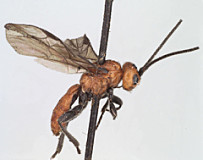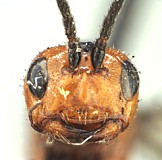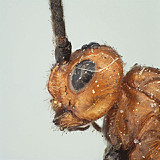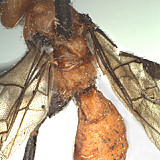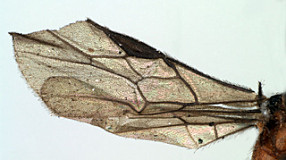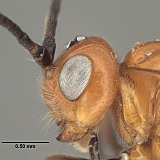Diachasmimorpha mexicana Cameron, 1887
In his redescription of this species, Fischer (1967b) noted that the specimen labeled as the type in BMNH is a male, but Cameron (1887) indicated in his original description that he was describing a female. The excellent figure in Cameron (1887) matches the type specimen, providing additional evidence of Cameron’s error (either misinterpretation of the male genitalia as an ovipositor or, more likely given the general quality of Cameron’s early work, a typographical error).
See additional remarks under Diachasmimorpha hildagensis (Fischer).
This species is very similar to Diachasmimorpha sanguinea (Ashmead). Careful comparison of the two suggests that Diachasmimorpha sanguinea is a more heavily sculptured species with a distinctly larger eye. Diachasmimorpha sanguinea has frequently been reared as a parasitoid of Zonosemata infesting Solanum in the southern U.S., whereas the name mexicana has previously been applied to the species attacking Rhagoletis in Mexico. After comparison of the holotype of mexicana in 2011 (Figs 1-5), I now conclude that the parasitoid of Rhagoletis in Mexico is not Diachasmimorpha mexicana due to differences in color and size of the eye.
Type locality: Mexico, D. F., Chapultepec.
Diachasmimorpha mexicana has been recorded as a parasitoid of Rhagoletis in Mexico (Rull et al. 2009), based on initial studies by Wharton. More detailed recent work indicates that the species attacking Rhagoletis is the newly described Diachasmimorpha martinalujai Wharton, and as a consequence, there are no confirmed records of hosts for the true Diachasmimorpha mexicana.
There are no specimens currently determined for this OTU, or those specimens determined for this OTU are not yet mappable.
Type
H. T.
The holotype was collected by D. Bilimek in Chapultepec and I have interpreted this as the large park that is now within Mexico City. Fischer (1967b) recorded the type label as type no. 3.c.505, but this is an inadvertent error. The type number for this specimen is 3.c.705.
Second label:
B. M. TYPE
HYM
3.c.705
Third label:
B.C.A. Hymen. I.
Opius
mexicanus
Cam.
Fourth label:
Opius
mexicanus
Cam. Type
BCA ii 409
Fifth label:
Bilimek
Mexico
1871.
Chapul
tepek
We thank David Wahl (AEIC) and Kees van Achterberg (RMNH) for extended loans of holotypes, as well as Dominique Zimmermann and Manuela Vizek (NHMW), Gavin Broad (BMNH), Robert Kula and Paul Marsh (USNM), Jenö Papp (HNHM) and Henri Goulet (CNC) for assistance with loans of types and/or other material in their care. This work could not have been accomplished without the collecting efforts of several people, most notably Martin Aluja and his lab, Juan Rull, Al Norrbom, and Robert Jones. Imaging and plate assembly was considerably facilitated by Trent Hawkins, Karl Roeder, Cheryl Hyde, Patricia Mullins, and Sophia Daniels. Patricia Mullins and Matt Yoder provided assistance with databasing and the HAO. This work was supported in part by NSF DEB 0949027 and NSF/PEET DEB 0328922, with REU supplements 1213790 and 0616851 respectively (all to RAW). The HAO is funded by NSF DBI 0850223 to Andy Deans, formerly at North Carolina State University. RW prepared the descriptions of new species, LW assisted RW with opiine taxonomy and general manuscript preparation, and IM contributed the HAO linkages and a critical review of the morphological terms used throughout the published work.

